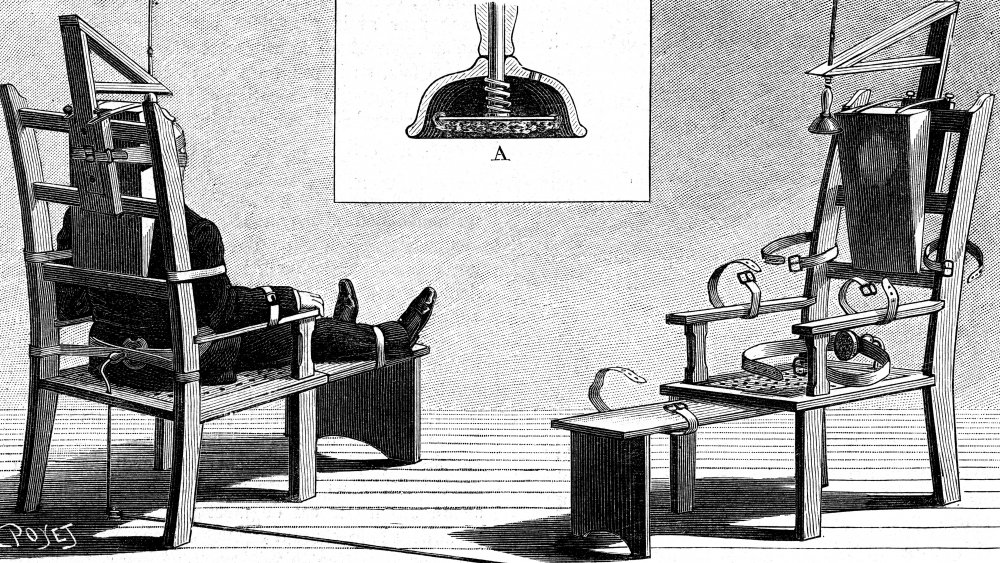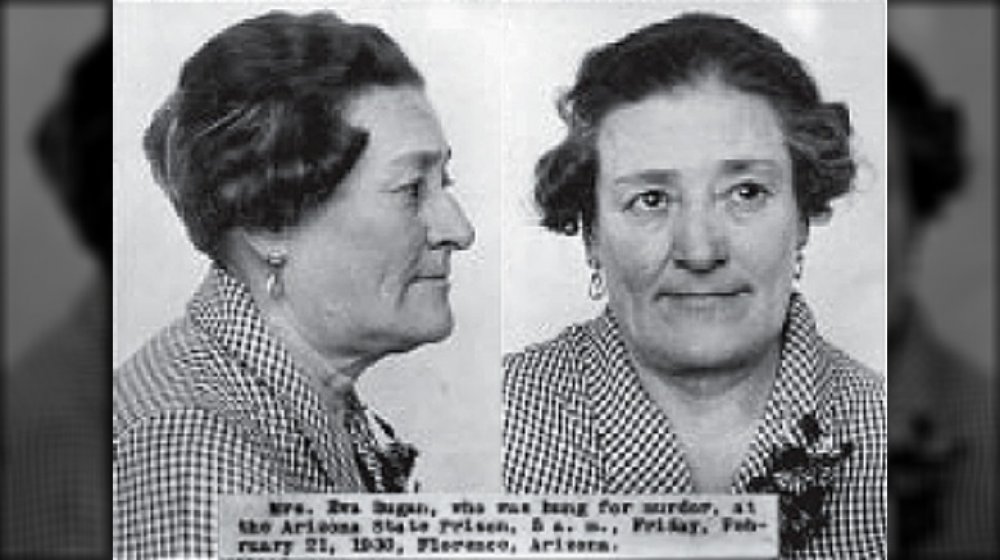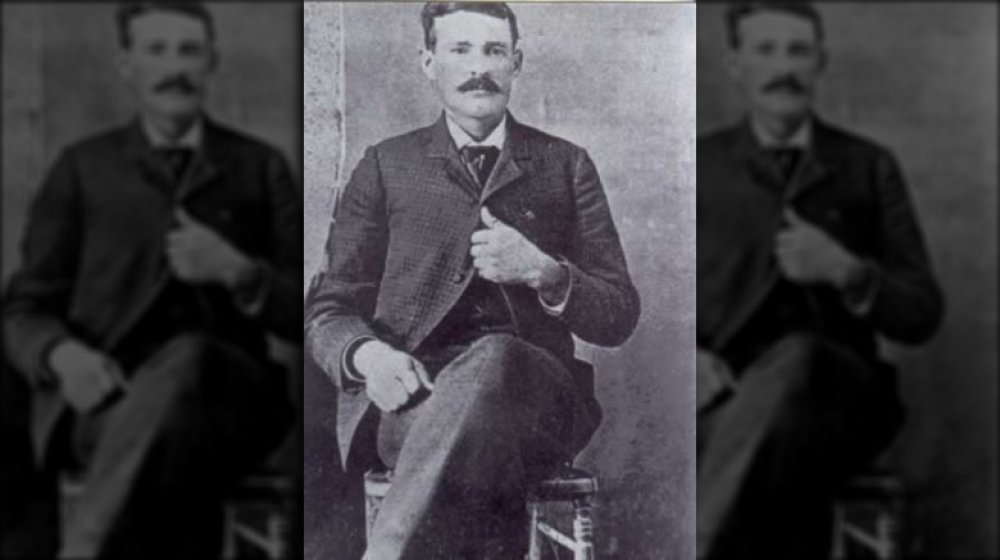Real-Life Executions That Went Wrong
The world is full of polarizing ideas, and at the top of anyone's list is the death penalty. It's one of those things that most tend to feel very strongly about, one way or the other: there's not a lot of wiggle room for opinions when it comes to taking the life of someone accused and convicted of some of the most terrible crimes imaginable.
Regardless of whether or not you're in favor of it, there's a few facts that are undeniable: convicts have faced execution for a very, very long time, and sometimes, those executions go horribly wrong. And we're not just talking about a little wrong... we're talking about a catastrophic kind of wrong.
And no, it really doesn't matter whether it's the electric chair, hanging, lethal injection, or... something else. It turns out the popular methods of execution aren't foolproof at all, and each have ways they can go terribly, nightmare-inducingly wrong.
New York's first execution by electric chair
Alfred Southwick heard about a man who touched an electric generator and died. That seems like the sort of thing that needs some serious fact-checking, and Southwick — who was apparently horrible — started electrocuting animals to make sure it worked and, long story short, got Thomas Edison on board with the death penalty (via The Washington Post). Now, all they needed was a test subject.
One presented itself in 1888. That's when William Kemmler got drunk and became convinced that his girlfriend was ready to run away with his buddy. They argued, he grabbed a hatchet, and started hacking. Afterwards, he went to a neighbor with the confession: he'd just killed his girlfriend. The trial was over quickly, says the Law Library, and there was a ton of discussion on whether or not it was a good idea to swap hanging for electrocution. It wasn't: as a reporter on scene wrote, "Probably no convicted murder of modern times has been made to suffer as Kemmler suffered."
Kemmler was initially shocked with 2,000 volts for 17 seconds, and when the current was shut off, he wasn't dead. Heck, he wasn't even unconscious. He continued to breathe while — and here's an extra-horrible part — they waited for the generator to power up, so they could shock him again. No one knows how long they kept the current on for the second time, but they did, finally, make sure that he was dead.
Just another day at the Tower of London
The date? 1541. The place? The Tower of London. The victim? Margaret Pole, Countess of Salisbury. The "why?" is complicated, so we'll sum it up like this: Margaret was George Plantagenet's daughter, and he was one of the biggest names in the War of the Roses. He was also on the losing side, and Margaret was married off to a Tudor early on. She was in close with the royal family — Historic Royal Palaces says she was even responsible for Mary I's education — but when Henry VIII started getting all choppy-choppy with his wives, her continued loyalty to Catherine of Aragon became a huge problem, even when Margaret retired to the country and just tried to live a quiet — but Catholic — life.
Unfortunately, her son — from the safety of the continent — started bad-mouthing the king, and the 65-year-old countess was imprisoned in the Tower. That was 1539, and after a small rebellion, Henry decided it was time.
Margaret's rank allowed her a semi-private execution via beheading, but there was only a novice executioner there at the time. Just what happened is up for debate — it's unclear whether or not she refused to kneel and put her head on the block — but regardless, Executed Today says the first blow missed. And so did the next nine or so. Most of those blows ended with the ax in her shoulders and back, making Margaret's death one more in a long line of Tudor atrocities.
Kidnapping gone wrong, execution gone wrong
On January 13, 1979, Ginggaew Lorsoungnern became the first woman to be executed in Thailand since 1942. Her sentence was handed down for her role in a horrible kidnapping gone wrong: the former domestic servant — along with two accomplices — kidnapped a 6-year-old boy from the family she had worked for. The ransom drop went bad when his parents missed the drop-off point in the dark, and the other two kidnappers stabbed and killed the child. In spite of the fact that she allegedly tried to protect him with her own body (and possibly, in part, because the coroner found the child had been buried alive) she was sentenced to death.
According to Executed Today, everything went by the book... at first. The guns were fired, the doctor confirmed she was dead, and her body was removed. But when she was transferred to the morgue... that's when she tried to get up. She definitely wasn't dead, and no one was sure about what to do next. When an attempt to strangle her didn't work either, they dragged her back to the chamber, strung her up again, and shot her again.
That time, it worked. What happened the first time? It was later confirmed that her heart wasn't in the normal place and as such, the initial round of bullets had torn open her chest but missed the vital organ. Her co-conspirators were executed — uneventfully — immediately afterwards.
It just wasn't her time
Anne Greene had no idea she was pregnant until the baby appeared, and according to Executed Today, the midwife later confirmed that the 17-week gestated fetus was stillborn and had never "had life." Still, the British Medical Journal says that Greene was condemned to death for murder.
Justice was swift in the 17th century, and on December 14, 1650 — just a few weeks after her arrest — Greene was taken to Cattle Yard in Oxford and hanged. She dangled at the end of the rope for around half an hour, and during that time, her friends... helped? Witness reports say some hit her in the chest, while "others handing with all their weight upon her legs, and sometimes lifting her up, and then pulling her down again with a sudden jerk, thereby the sooner to despatch her out of her pain." Then, they cut her down and took her to the anatomist, which was pretty standard for the time: the body of anyone who was executed for crimes was sent for anatomical dissection.
But here's where the story took an unexpected turn: as William Petty and Thomas Willis were preparing for her dissection, she started to breathe. They revived her by pouring a hot cordial into her mouth, bleeding her, applying compression bandages, giving her an enema, then putting her in bed with another woman to keep warm. Within two days she made a complete recovery, and went on to marry, have three children, and live another 15 years.
An execution gone horribly wrong... in two ways
It all started when Sonia Jacobs, Jesse Tafero, and Walter Rhodes were asleep in a car they'd parked off Florida's Interstate 95. They were approached by a Florida Highway Patrol officer and a friend who happened to be a Canadian constable. It came to light that Rhodes had a criminal record: there was gunfire, and when it was over, the two law enforcement officers were dead.
Just what happened was up for debate: Jacobs and Tafero swore that it was Rhodes who had done the shooting, but according to Northwestern, Rhodes was allowed to plead guilty to reduced charges for his testimony against Tafero. Tafero was found guilty — by a jury who had known about the case before being selected, and who hadn't been sequestered — and in 1990, Tafero was sent to the electric chair.
And that electric chair malfunctioned, botching the execution so badly that not only was he set on fire, but according to History, it was the case that kicked off a whole new debate about the death penalty, and ultimately led to Florida switching from the electric chair to lethal injection.
Here's another footnote: Jacobs and Tafero were convicted by the same evidence, and in 1992, a judge overturned Jacobs' conviction.
Wishing for death to just come already
Doyle Lee Hamm was sentenced to die on February 22, 2018. He didn't, but according to the medical report (via NBC News), to die was all that he'd wanted to do. The Intercept says that Hamm was arrested in 1987. The charge? Being the gunman in a robbery gone bad, one that ended with the fatal shooting of a motel clerk. He sat on death row for almost 30 years until 2018 rolled around, and Hamm — who was in the process of undergoing treatment for large-cell lymphoma — had his execution scheduled to begin at 6 pm.
After a brief stay of execution, proceedings started at 8:45, and what followed was hours of pain. Because of Hamm's years of drug use and recent cancer treatments, the very thing medical professionals had warned them about did, indeed, happen: the executioners couldn't find a vein. For two and a half hours, Hamm lay strapped to a gurney as he was stuck over and over again with needles. Dr. Mark Heath would later recount: "During this time Mr. Hamm began to hope that the doctor would succeed in obtaining IV access so that Mr. Hamm could 'get it over with' because he preferred to die rather than to continue to experience the ongoing severe pain."
The execution was called off as midnight approached, and the following month, it was reported (via Prison Legal News) that the Alabama Department of Corrections agreed there would be no further execution date set.
The man they couldn't hang
John "Babbacombe" Lee didn't just survive one botched execution, he survived three. According to the BBC, he was convicted of the murder of a woman named Miss Emma Anne Whitehead Keyse. She died in November 1884, and Lee became a prime suspect... largely because of circumstantial evidence, like a cut on his arm. Still, he was found guilty and sentenced to hang on February 23, 1885.
What happened next was... inexplicable. The executioner said that everything was in working order when he threw the lever to open the trap door, verifying that the execution was going to go smoothly. But when they put the noose around Lee's neck and threw the lever, the trap door didn't open. After the third attempt, they took him down. His sentence was commuted to a life of penal servitude, but he was released after serving 22 years in prison.
It's unclear what happened to him afterwards — the Smithsonian suggests there's evidence that he deserted his British family and had another in America before dying in 1945. But that — along with his guilt or innocence — is just a matter of conjecture.
From housekeeper to car thief to murderer
When she worked as a lady-of-the-night during the Alaskan Gold Rush, True West Magazine says she was known as Claw-Finger Kitty. Three decades later, she was known simply as Eva Dugan... and there was a lot that happened in the meantime.
That includes, says the Arizona Historical Society (via AZCentral), the mysterious disappearance of four out of her five husbands. That little tidbit of information fell into place later: what led to Dugan's conviction was the disappearance of her employer, a chicken rancher named Andrew Mathis, in 1927. He vanished with all his earthly possessions, and after she sold his car in Kansas City and moved to White Plains, New York, there were suspicions. Then, when Mathis' skeleton turned up — he had been buried in a shallow grave after being killed with an ax — authorities had their charges. Even though Dugan claimed a missing accomplice had killed Mathis in self-defense, she was sentenced to hang.
And Dugan did hang, on February 21, 1930. There were a handful of witnesses and reporters, and one — from The Republic — wrote: "Horror filled the execution chamber when the rope broke and snapped off the woman's head." Her head rolled toward the spectators, and men and women alike fainted. After that, there were only two more official hangings in Arizona, before the state switched to the gas chamber in 1934.
The repeat murderer
Jimmy Lee Gray's crimes are the stuff of nightmares, and they started when he was 18-years-old. That was in 1968, and it's when he killed his 16-year-old girlfriend, Elda Prince. According to Capital Punishment UK, he was sentenced to 20 years, but he only served six, and was released on parole in spite of some major protests.
He sort of dropped off the radar until 1976, and reappeared in a truly awful way: when he abducted a 3-year-old girl named Deressa Jean Scales. The medical examiner reported that she had been sexually assaulted, gagged, had a piece of clothing forced down her throat, and was finally drowned in a muddy ditch. When it came time, it took a jury just about an hour to hand out a guilty verdict. After a series of appeals, he was sentenced to execution in Mississippi's gas chamber, and in 1983, his last appeal was dismissed by the US Supreme Court. His execution was set for the following day.
It didn't go smoothly. According to Executed Today, the witnesses were cleared out about eight minutes after the gas was released, and Gray continued to thrash and struggle, slamming his head repeatedly into a metal pole that had been positioned behind the chair. The state said that it only took two minutes for him to die, but witnesses said otherwise. Not everyone was upset about it: his mother had encouraged the state to go ahead with the execution.
It started with a bullet and ended with a noose
Thomas "Black Jack" Ketchum was a train robber, and he was a pretty big deal. Legends of America says that he'd been robbing trains for around seven years, and it's possible he would have kept robbing trains had a bullet not knocked him off the Colorado and Southern Railway on August 16, 1899. Law enforcement found him the next day, according to the Eastern New Mexico News. He became the only person to hang for "felonious assault upon a railway train."
His hanging was actually delayed a few times, until law enforcement got wind that some of his gang were planning on trying to free him. So, on April 26, 1901, he went to the gallows... and it was the kind of major event that people needed to buy a ticket for. They could also buy souvenirs, including Black Jack Ketchum dolls, hanging by their necks at the end of a stick.
There's no word on how keen people were to keep the dolls after the way the hanging went. The night before, the gallows, trap door, and rope had been tested with the help of a 200-pound sandbag, but when it came time for the hanging, they forgot the sandbag was still attached. Ketchum was immediately decapitated, spraying the crowd with blood. His head stayed in the bag that had been pinned to his shirt.
He picked a good time to wake up
There's not a heck of a lot of detailed information about William Duell, but that's not entirely surprising. He went to the noose on November 24, 1740, and at the time, he was just 16-years-old. His crime? Rape and murder.
According to Dissecting the Criminal Corpse, Duell's execution was controversial... particularly because of what followed. The Lancet says that at the time, it was pretty standard practice for the bodies of criminals to be taken to anatomists to be dissected. It was, after all, a time when we were still learning a lot about the human body, and dead bodies needed to come from somewhere. It was better than grave robbing, but still, anatomists and surgeons were considered sort of a second set of eyes when it came to confirming death... lest their first cuts with a blade be the actual cause of death.
And that was almost the case with Duell. He swung at the end of the rope for 22 minutes, but it wasn't until he was being prepped for dissection that surgeons realized he was still alive. He was revived, and given that his sentence — to hang "until he were dead" — hadn't exactly been carried out, he got a pass: his punishment was changed to transportation. The British Library says he was sent to North America.
Think you're tough? You've got nothing on this guy
Not everyone who is sentenced to die committed your standard sort of crimes. Take Konstantin Petrovich Feoktistov. According to German Waffen-SS officers, his crime was serving in the Soviet Army. When he was 16-years-old, his hometown of Voronezh came under Nazi occupation. According to The Independent, he actively started gathering intelligence, until he was caught and sentenced to death by firing squad.
And here's where things get really nuts. He went in front of the firing squad, and they very definitely shot him. The bullet went through his chin and neck; somehow, he had the presence of mind to play dead, even as he was dumped into a burial trench. He crawled out, made it to Soviet lines, and survived.
That's pretty epic, and so is what he did after the war. After going to the Bauman Moscow Higher Technical School and spending some time working as a factory engineer, he got his doctorate in physics, helped design spacecraft (including Sputnik and Vostok), and in 1964, he made history: he was one of a three-man crew who were the first to fly into space.












